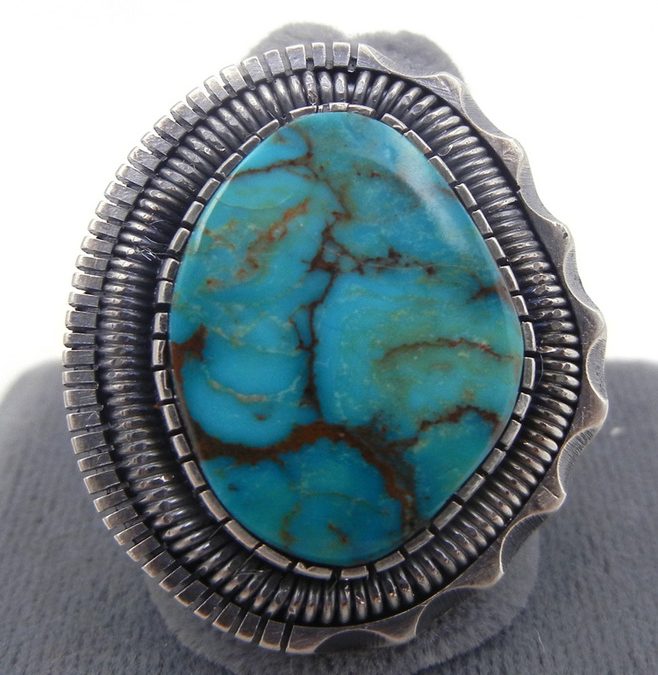The “living” stone of turquoise remains the heart of Navajo jewelry. Its perceived powers and color-changing abilities captivate everyone from artisans to admirers.
Inspired by Spaniards, the techniques used to make Navajo turquoise jewelry keep with tradition but have expanded into intricate and inspiring designs.
What is turquoise?
Turquoise is categorized as a semi-precious stone. Often referred to as a “living” stone, turquoise was one of the first stones used and worn by people across various ancient civilizations.
Turquoise is a blue to blue-green semi-precious stone that can change colors over time dependent on certain factors:
- Environment
- Light
- Dust
- Skin acidity
Turquoise may also show the presence of its mother stone. The mother stone is what turquoise forms within. When traces of the mother stone remain within the turquoise stone, it causes a matrix. The matrix comes in different patterns, colors, and lines.
One way to tell the difference between faux and real turquoise is to feel the stone’s surface. Turquoise with a matrix will feel rough where the matrix is present. The lines should feel indented into the turquoise. Faux turquoise will feel smooth where the matrix is visible.
What did turquoise mean to the Navajo people?
The Navajo people treasured this alluring gift from the Earth. For them, it possessed the powers to protect, bring luck, and heal.
Before the Navajo learned silversmithing to make jewelry, they used turquoise in other ways. Warriors carried turquoise for protection. Hunters carried it for luck on their missions. Turquoise hung around dwellings to protect them from evil spirits.
The Navajo people also used turquoise as a barometer for one’s health. They believed that the changes in color caused by people wearing turquoise communicated the state of one’s health. Navajo used turquoise to also restore health for those that needed it.
The Navajo have a goddess, Estsanatlehi (Changing Woman), that is said to adorn turquoise while living in a turquoise house on the western horizon. She symbolizes the coming of age for young women. Today, young Navajo women wear turquoise jewelry during their coming-of-age ceremonies.
Turquoise also became a symbol of wealth and status. The larger the turquoise pieces worn, the more prestigious the person is perceived to be.
The Navajo used turquoise as currency amongst each other. Later on, the Navajo began using their turquoise jewelry for trading.
When did the Navajo begin making turquoise jewelry?
In the mid-1880s, the silver adornments the incoming Spaniards wore caught Atsidi Sani’s eye. He was a blacksmith that convinced a Spanish silversmith to show him how he made the silver adornments.
Using everything from canteens, buckles, and even melted down silver coins, Atsidi Sani found a growing market amongst his people for this jewelry. He then began training others, including his sons, to master this delicate craft.
It wasn’t until the early 1900s that the Navajo began incorporating turquoise into their silver jewelry. Atsidi Chon was the first to use turquoise in his Navajo jewelry creations. He then taught the Zuni tribe silversmithing.
During this time, Navajo turquoise jewelry started becoming popular with Spaniards and other people settling into the Southwest.
The Squash Blossom Necklace
One of the most well-known and sought after designs of Navajo turquoise jewelry is the squash blossom necklace. This design was also inspired by the incoming Spaniards of that time.
The pendant of this necklace features the Naja (crescent). This shape was thought to have originated in the Middle East, where it was used to ward off the evil eye. The Spaniards adopted this symbol and brought it with them as they traveled to the Americas. It is here where the Navajos first encountered this symbol and also adopted it for their use.
Climbing up from the Naja on both sides of the necklace are smaller beads or smaller ornamental pieces meant to replicate the flowers, or blossoms. Inspired by their natural surroundings, the squash blossom necklace signifies esteem and importance to those who wear them today.
What is Navajo turquoise jewelry like today?
Navajo turquoise jewelry today resembles the traditions and techniques used in the past. While keeping with the past, modern Navajo jewelry has progressed with the changing times.
Modern artisans now use inlay techniques and clustered stone styles. Other stones, such as coral, lapis, and malachite, have also been incorporated.
Though silver is still commonly used, different colors of gold can now be seen being paired with turquoise. The pureness of the silver used today lends to a smoother shine and glossier look.
The versatility of Navajo turquoise jewelry is endless. Navajo jewelry makes the perfect complement for both casual attire and formal wear. The pieces can be smaller for a demure look or larger to pose as statement pieces.
Turquoise may be kept in its original form or carved and cut to produce finer shapes and sizes.
Most people think of Navajo turquoise jewelry as being a Southwestern look, but these pieces complete any fashion. Some like to layer pieces of Navajo jewelry when finishing an eccentric Bohemian look, while others use these pieces to add color to office attire.
Who sells Navajo turquoise jewelry?
Palms Trading Company specializes in authentic Navajo turquoise jewelry, and we buy directly from genuine artisans. Our turquoise is certified for authenticity, and pieces are clearly labeled if authenticity can’t be verified.
Contemporary Navajo jewelry is also available on our online store. If you’re looking for antique Navajo jewelry in New Mexico, you can check out our physical store in Albuquerque.
Have questions? Contact us today to speak to one of our knowledgeable professionals!



